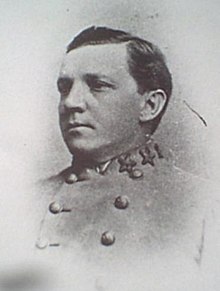William P. Roberts (July 11, 1841 – March 28, 1910) was an American politician and diplomat. He was also a senior officer of the Confederate States Army who commanded cavalry in the Eastern Theater of the American Civil War. Promoted to Brigadier-General at the age of 23, he was the youngest Confederate general.
William P. Roberts | |
|---|---|
 Roberts in uniform, c. 1864 | |
| 4th Auditor of North Carolina | |
| In office 1881–1889 | |
| Preceded by | Samuel L. Love |
| Succeeded by | George W. Sandlin |
| Personal details | |
| Born | William Paul Roberts July 11, 1841 Gates County, North Carolina |
| Died | March 28, 1910 (aged 68) Norfolk, Virginia |
| Resting place | Gatesville, North Carolina |
| Political party | Democratic |
| Military service | |
| Allegiance | |
| Branch/service | |
| Years of service | 1861–1865 |
| Rank | |
| Commands | Roberts' Cavalry Brigade |
| Battles/wars | American Civil War |
Early life
editWilliam Paul Roberts was born July 11, 1841, in Gates County, North Carolina, the son of John S. and Jane Roberts.[1]
American Civil War
editIn 1861, at the age of 19, Roberts enlisted as a private in Company C of the 19th Regiment North Carolina Infantry, which would later be designated as the 2nd Regiment NC Cavalry. Having served with distinction during regimental operations in North Carolina, but with no formal military training, he was promoted to second lieutenant on August 30, 1861. On September 13, 1862, Roberts was promoted to First Lieutenant. Roberts' regiment was transferred to Virginia in the fall of the same year and took part in several battles, among them: Battle of Fredericksburg, Battle of Suffolk, and Battle of Brandy Station. On November 13, 1863, Roberts was promoted to captain and then major before the spring of 1864, when he fought in the North Carolina brigade of William Henry Fitzhugh Lee's division. He was promoted to colonel in June 1864 and during the Siege of Petersburg, he was given command of the 2nd Regiment NC Cavalry. Roberts led a charge against Union breastworks, dismounted, overtook the rifle pits and captured several Union soldiers at the Second Battle of Ream's Station on August 25, 1864. On February 23, 1865, Roberts was promoted to brigadier general. According to tradition, General Robert E. Lee presented Roberts with Lee's personal gauntlets in recognition of Roberts' distinguished service. Roberts continued the command of his brigade at the Battle of Five Forks, and eventually surrendered at the Battle of Appomattox Court House, on April 9, 1865.[1]
Later life
editFollowing the War, Roberts returned to Gates County, North Carolina, where he married Eliza Ann Roberts. He entered state politics as the representative for Gates County at the Constitutional Convention in 1875. In 1876, Roberts was elected to the North Carolina legislature. He eventually became the Auditor of North Carolina and served in that capacity from 1880 until 1888.[1] In 1889, President Grover Cleveland appointed him United States Consul for Victoria, British Columbia.[2]
Death
editRoberts died in Norfolk, Virginia, on March 28, 1910. He is buried in his home county at Gatesville, North Carolina.[1]
See also
edit- Galusha Pennypacker, youngest Union Army general
- List of American Civil War generals (Confederate)
Notes
edit- ^ a b c d "Civil War Veterans of Northeastern North Carolina – Biographies". Archived from the original on October 26, 2009. Retrieved June 28, 2008.
{{cite web}}: CS1 maint: bot: original URL status unknown (link) at www.geocities.com - ^ NC Historical Marker
References
edit- Eicher, John H., and David J. Eicher, Civil War High Commands. Stanford: Stanford University Press, 2001. ISBN 978-0-8047-3641-1.
- Sifakis, Stewart. Who Was Who in the Civil War. New York: Facts On File, 1988. ISBN 978-0-8160-1055-4.
- Warner, Ezra J. Generals in Gray: Lives of the Confederate Commanders. Baton Rouge: Louisiana State University Press, 1959. ISBN 978-0-8071-0823-9.
External links
edit- "Web biography". Retrieved June 16, 2020.[dead link]